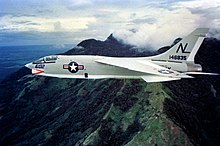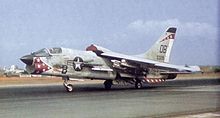Vought F-8
| Vought F-8 Crusader | |
|---|---|
 F-8E of the US Marine Corps' VMF (AW) -212 Fighter Squadron |
|
| Type: | Fighter plane |
| Design country: | |
| Manufacturer: | |
| First flight: |
March 25, 1955 |
| Commissioning: |
March 1957 |
| Production time: |
1955 to 1965 |
| Number of pieces: |
1261 |
The Vought F -8 Crusader (until 1962 F8U) was a single - engine fighter aircraft made in the USA , which was mainly used on aircraft carriers . The prototype first flew on March 25, 1955, a total of 1261 Crusaders were built. It was the last type of aircraft whose primary armament was a machine gun , which is why it was nicknamed The Last of the Gunfighters .
history
In 1953 the Chance Vought Division of the United Aircraft Corporation received an order to develop a carrier-supported supersonic fighter aircraft . Flight testing of the prototype XF8U-1 began in March 1955, using a Pratt & Whitney J57-P-12 as a propulsion system. A short time later, serial production began, which ran until 1965, and the first F8U-1, which was reclassified as F-8A in 1962, flew on September 20, 1955. The F-8A initially had the same engine as the prototype, later all machines received the more powerful J57-P-20A or -22.
The Crusader was used in the US Navy and the US Marine Corps primarily as a carrier-based interceptor . Numerous samples of the model were used in the Vietnam War . In 1957, then major in the US Marine Corps and later astronaut John Glenn set a new transcontinental speed record. The route from Los Angeles to New York City only took him 3:23 hours at an average speed of Mach 1.1. The machine was refueled three times in the air .
On May 25, 1972, NASA launched a modified Vought F-8 “Crusader”, the first aircraft with digital fly-by-wire , which worked on the basis of the on-board computer of the Apollo program's lunar module ( Apollo Guidance Computer ).
technology

The specialty of this aircraft is the hydraulically adjustable by 7 ° angle of the wing with a sawtooth , which are swept by 45 °. This allows a high angle of attack during the landing approach to an aircraft carrier without impairing the forward view at the same time. However, this construction increased the maintenance effort of the F-8. Otherwise, the model was provided with the usual porter equipment (folding wings, catch hooks, catapult fittings). To improve the aerodynamics, the cabin was fully integrated into the contour of the fuselage. In some versions, the nose landing gear has been moved to the right to create space for an additional weapon station under the fuselage.
Versions
- F-8A (F8U-1)
- First series version (318 machines) with four 20 mm cannons, a container with 32 unguided FFAR missiles and two AIM-9 Sidewinder guided missiles; the first deployment took place in 1957 in the VF-32 squadron from the USS Forrestal .
- DF-8A
- Conversion of F-8A to control aircraft for Regulus cruise missiles
- RF-8A (F8U-1P)
- Unarmed reconnaissance aircraft, of which 144 machines were built; the first deployment took place in 1957 in the VFP-61 squadron from the USS Midway .
- QF-8A
- Conversion of some F-8A to (unmanned and remote-controlled) drones
- TF-8A (XF8U-1T)
- Conversion of an F8U-1 ( BuNo 143710 ) to the XF8U-2NE prototype, then converted to the XF8U-1T, a two-seat training aircraft. An order for twelve F8U-1Ts has been canceled. XF8U-1T renamed TF-8A in 1962, then used at NASA as NTF-8A. The Navy also used the TF-8A designation for single-seat F-8A, which were used for training purposes.
- F-8B (F8U-1E)
- 130 machines that were conditionally suitable for all weather conditions using an AN / APS-67 radar
- F-8C (F8U-2)
- 187 machines with a more powerful J57-P-16 engine and improved avionics
- F-8D (F8U-2N)
- 152 machines with a more powerful J57-P-20 engine as well as improved all-weather suitability and four AIM-9s
- F-8E (F8U-2NE)
- 286 machines with APQ-94 fire control radar and two under wing stations for bombs
- F-8E (FN)
- 42 F-8E were delivered to France, which were equipped with APQ-104 radar for compatibility with the Matra-R.530 guided missile and a two-stage wing adjustment with a maximum of 7 ° instead of 5 ° for a slower approach speed to the smaller French aircraft carriers . Twelve machines were modernized with French avionics from 1992-1995 and later designated as F-8P .
- DF-8F
- Conversion of at least eleven machines into steering and control aircraft for unmanned missiles
- RF-8G
- Modernization of 73 RF-8A machines with a more powerful J57-P-22 engine, ventral fins, the ability to carry external loads and improved avionics.
- F-8H
- 89 modernization of some F-8D, of which 25 machines were from the Philippines as F-8P used
- F-8J
- 136 modernized F-8E
- F-8K
- 87 modernized F-8C
- F-8L
- 61 modernized F-8B
commitment
The F-8 was used in all conflicts of the 1960s, especially the Vietnam War. Already during the Cuban Missile Crisis in 1962 the reconnaissance squadron VFP-62 flew reconnaissance over Cuba from land bases. In August 1964, the VF-51 and VF-53 fighter squadrons of the carrier USS Ticonderoga were involved in retaliatory attacks on North Vietnamese speedboat bases after the Tonkin incident . This marked the beginning of the actual Vietnam War for the USA. In June, however, an RF-8A of the reconnaissance squadron VFP-63 Det. C of the carrier USS Kitty Hawk had been shot down over Laos. In total, the US Navy and US Marine Corps lost 139 F-8s and 29 RF-8s in Vietnam. For their part, F-8 pilots shot down 18 North Vietnamese aircraft. The F-8's use of the US Navy ended in 1976 with the retirement of the last Essex-class carrier , USS Oriskany . As part of the CVW-19 squadron, the VF-191 and VF-194 fighter squadrons with F-8J were used here. The RF-8G was last used in 1982 by VFP-63 in the CVW-14 squadron on USS Coral Sea . The reserve squadron VFP-206 retired the last RF-8G on March 29, 1987. In 1977 the Philippines bought 35 F-8H. 25 were used as F-8Ps until 1991, ten were used as spare parts donors. The French Naval Squadron 12F put the last F-8E (FN) out of service on December 4, 1999.
Users
-
 France
France
- Aéronavale
-
 Philippines
Philippines
- air force
-
 United States
United States
- US Navy
- US Marines
- NASA
Technical data F-8J
| Parameter | Data |
|---|---|
| length | 16.61 m |
| span | 10.87 m |
| height | 4.80 m |
| Wing area | 34.84 m² |
| Takeoff mass | normal 13,150 kg, maximum 15,422 kg |
| Top speed | 1800 km / h at an altitude of 12,190 m |
| Marching speed | 900 km / h at an altitude of 11,000 m |
| Climbing time to 12,200 m | 5 min |
| Summit height | 17,680 m |
| Range | normal 1609 km, maximum 2250 km |
| Engine | a Pratt & Whitney J57- P-20A; 4850 kp without and 8165 kp with afterburner |
Armament
- Permanently installed automatic cannons in the bow
- 4 × 20-mm machine gun Colt-Browning Mk.12 , each with 125 to 144 rounds of ammunition
- Permanently installed in a retractable rocket bundle on the underside of the fuselage (F8U-1 / F-8C only)
- 1 × FFAR rocket launcher (with 32 unguided Mk.4 FFAR rockets "Mighty Mouse"; caliber 70 mm / 2.75 inch)
- Armament up to 2268 kg at four external load stations under the two wings and on the side of the fuselage
- Air-to-air guided missiles
- 4 × LAU-7 / A starter rails on Y-shaped carriers for 2 × Ford AIM-9B / C "Sidewinder" each - thermal image-controlled short-range air-to-air guided missile
- 2 × launch rails for 1 × Matra R.550 Magic each (only F-8E (FN)) - thermal image-controlled short-range air-to-air guided missile
- 2 × launch rails for 1 × Matra R.530 each (F-8E (FN) only) - radar-guided short-range air-to-air guided missile
- Air-to-ground guided missiles
- 2 × Martin-Marietta AGM-12C "Bullpup" - radio-controlled guided missiles
- Unguided air-to-surface missiles
- 4 × double rocket launchers (for 2 × unguided Zuni air-to-ground missiles, caliber 127 mm / 5 inch)
- 2 × LAU-10D / A rocket launchers (for 4 × unguided Zuni air-to-surface missiles each, caliber 127 mm / 5 inch)
- Unguided bombs (on two bomb carrier racks BRU-41 MER or BRU-42 TER)
- 12 × Mk.81 (113 kg / 250 lb free fall bomb )
- 8 × Mk.82 LDGP (227 kg / 500 lb free fall bomb)
- 8 × Mk.82 SE "SnakeEye" (227 kg / 500 lb, with four air brake flaps)
- 4 × Mk.83 LDGP (454 kg / 1000 lb free-fall bomb)
- 2 × Mk.84 LDGP (907 kg / 2000 lb free fall bomb)
- 4 × M117 (372 kg / 820 lb free fall bomb)
See also
Web links
Individual evidence
- ↑ Tomayko, James E .: Computers Take Flight: A History of NASA's Pioneering Digital Fly-by-Wire Project . 2000 ( nasa.gov [PDF]).







